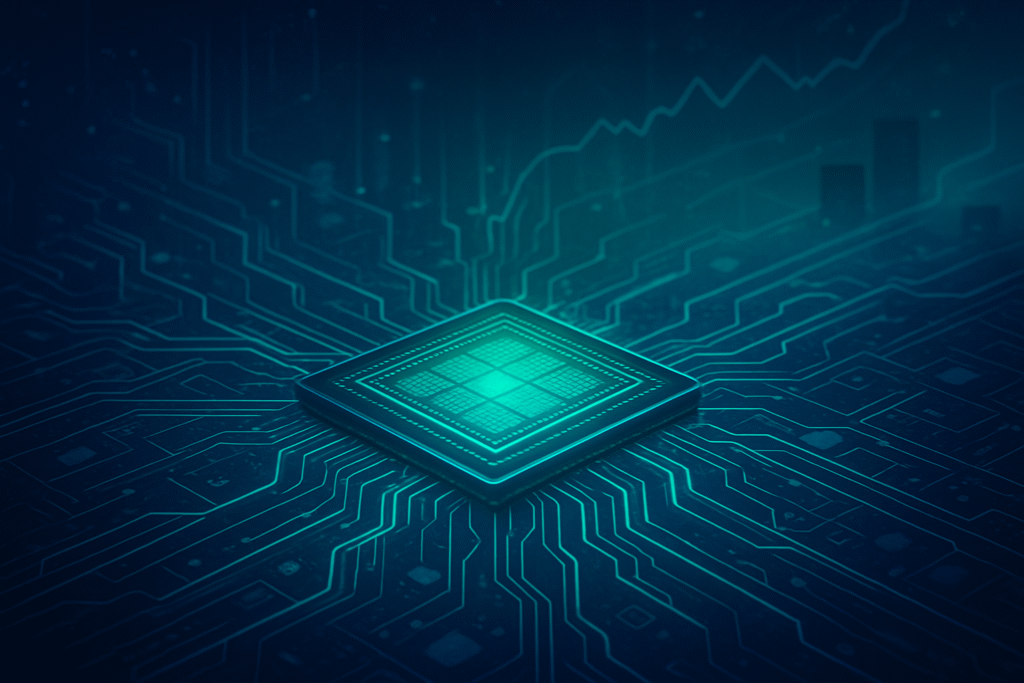
In a testament to the transformative power of artificial intelligence, Nvidia Corporation (NASDAQ: NVDA) has ascended to an unprecedented market capitalization of approximately $4.55 trillion as of October 2025, cementing its position as the world's most valuable company. This staggering valuation is a direct reflection of the insatiable global demand for its state-of-the-art AI accelerators, which have become the foundational infrastructure for the burgeoning AI economy. The company's relentless innovation, epitomized by its Hopper and the recently introduced Blackwell architectures, continues to drive the AI revolution, making Nvidia the undisputed leader in the AI chip market and a pivotal force shaping the future of technology.
Nvidia's dominance is not merely a financial triumph but a technological one, underscored by its continuous stream of groundbreaking chip releases. The Hopper architecture, launched in September 2022, and the even more advanced Blackwell architecture, announced in March 2024 and progressively rolling out through 2025, represent significant leaps in computational power and efficiency. These chips are the backbone of large language models (LLMs), generative AI, and high-performance computing, enabling advancements that were once considered theoretical. The immediate significance of these developments lies in their ability to accelerate AI training and deployment at an unprecedented scale, making sophisticated AI more accessible and powerful for a vast array of industries and applications.
Unpacking the Power: Hopper and Blackwell Architectures
Nvidia's market leadership is firmly rooted in its relentless pursuit of innovation, with the Hopper and Blackwell architectures serving as the twin pillars of its current dominance. The Hopper architecture, named after computer science pioneer Grace Hopper, was officially unveiled in March 2022 and saw its primary products, like the H100 Tensor Core GPU, launch in September 2022. Designed specifically for demanding AI, high-performance computing (HPC), and data center workloads, Hopper introduced several transformative technologies. Key among these are its fourth-generation Tensor Cores, which dramatically accelerate matrix operations crucial for deep learning, and the groundbreaking Transformer Engine with FP8 precision. This engine dynamically adjusts computational precision, optimizing throughput for AI training tasks by leveraging lower, faster precisions when acceptable. Hopper also integrated advanced memory subsystems, utilizing High-Bandwidth Memory (HBM3) and later HBM3e in the H200 GPUs, offering substantial bandwidth improvements (e.g., 3 TB/s) vital for data-intensive AI. Enhanced NVLink and Multi-Instance GPU (MIG) technology further bolstered its capabilities, making the H100 and H200 indispensable for large-scale AI training and generative AI models.
Succeeding Hopper, the Blackwell architecture represents Nvidia's next monumental leap, announced in March 2024 with a phased rollout through 2024-2025. Blackwell aims to redefine the economics of generative AI, promising to enable the building and running of trillion-parameter LLMs at up to 25 times less cost and energy consumption compared to its predecessor. This architecture introduces six transformative technologies designed for accelerated computing. While data center and industrial Blackwell GPUs (B100/B200) experienced some packaging complexities and phased releases, consumer RTX 50-series GPUs, also based on Blackwell, began launching in January 2025, with high-end models like the RTX 5090 making their debut. A critical innovation in Blackwell is the fifth-generation NVLink interconnect, boasting 1.8 TB/s of bidirectional bandwidth per GPU. This allows for seamless communication across up to 576 GPUs within a single cluster, addressing the escalating demands of increasingly complex AI models.
The technical advancements in Blackwell differentiate it significantly from previous approaches. The sheer scale of interconnected GPUs possible with the new NVLink, combined with further optimizations for sparse matrix operations and enhanced energy efficiency, positions Blackwell as a platform capable of tackling the next generation of AI challenges. Initial reactions from the AI research community and industry experts have been overwhelmingly positive, with many hailing Blackwell as a necessary and timely innovation to keep pace with the exponential growth of AI model sizes and computational requirements.
The transition from Hopper to Blackwell underscores a continuous cycle of innovation where each generation builds upon the last, pushing the boundaries of what's computationally feasible. While Hopper set the standard for the current wave of generative AI, Blackwell is poised to elevate it further, offering a platform for even more ambitious and complex AI systems. This iterative yet revolutionary approach ensures Nvidia maintains its technological edge, providing the foundational hardware for the most advanced AI applications across the globe.
Shifting Tides: The Reshaping of the AI Industry Landscape
Nvidia's (NASDAQ: NVDA) record-breaking valuation and the successive releases of its Hopper and Blackwell AI chip architectures have undeniably reshaped the competitive landscape for AI companies, tech giants, and burgeoning startups alike. The sheer computational prowess and efficiency offered by these chips are not just incremental upgrades; they are foundational enablers that dictate the pace of innovation and market positioning across the entire AI ecosystem.
Beneficiaries and Strategic Alliances: The most immediate and significant beneficiaries are the major AI labs and cloud service providers (CSPs). Tech giants like Amazon (NASDAQ: AMZN) with AWS, Microsoft (NASDAQ: MSFT) with Azure, and Alphabet (NASDAQ: GOOGL) with Google Cloud are heavily reliant on Nvidia's GPUs to power their vast data centers and offer cutting-edge AI services to their clientele. These hyperscalers are investing hundreds of billions into foundational AI infrastructure, much of which is outfitted with Nvidia's hardware. Strategic partnerships, such as Nvidia's reported $100 billion commitment to OpenAI to deploy 10 gigawatts of Nvidia systems, or collaborations with Oracle (NYSE: ORCL) on the $500 billion "Stargate" project, underscore the critical role Nvidia plays in the development of next-generation AI. For AI companies, particularly those developing large language models and generative AI applications, the enhanced performance and scalability of Hopper and Blackwell chips translate directly into faster training times, more complex models, and quicker deployment, accelerating their development cycles and time to market.
Competitive Implications and Disruption: Nvidia's near-monopoly in high-end AI accelerators presents a formidable challenge to other chip manufacturers. While Advanced Micro Devices (NASDAQ: AMD) with its Instinct MI series and Intel (NASDAQ: INTC) with its Gaudi accelerators are striving to carve out market share, they face an uphill battle against Nvidia's established ecosystem, particularly its robust CUDA software platform. This integrated hardware-software "moat" makes it incredibly difficult for rivals to replicate Nvidia's offerings and keeps developers tethered to its platform. The rapid advancements in AI chips are leading to potential disruptions across various products and services. New applications become feasible, existing ones become more efficient, and data center architectures are continually evolving. However, this also raises concerns about the escalating capital expenditures required to acquire these advanced chips and the immense energy consumption of massive AI data centers, which could strain power infrastructures and increase operational costs.
Market Positioning and Strategic Advantages: Nvidia's strategic advantages are multifaceted. Its Hopper and Blackwell chips set the industry standard for performance and efficiency, while the CUDA platform fosters a sticky developer ecosystem. Deepened alliances with key players like OpenAI, Microsoft, and Oracle secure future demand and integrate Nvidia's hardware into critical AI infrastructure. The company's impressive financial performance, characterized by high revenue growth and gross margins, further reinforces its market position. For startups, while Nvidia's powerful chips offer unprecedented access to high-performance computing, enabling them to innovate, they also face the challenge of high capital expenditure. Nvidia actively supports startups through initiatives like Nvidia Inception and direct investments, often backing companies across various AI sectors, which in turn drives demand for its core products. However, there's a growing awareness of the potential for a "circular" AI ecosystem where large companies invest in their customers to ensure chip demand, raising questions about market dynamics and accessibility for smaller players. Meanwhile, some tech giants, like Meta Platforms (NASDAQ: META), are increasingly motivated to develop their custom AI silicon to reduce reliance on external suppliers, signaling a potential shift in the long-term competitive landscape.
A New Era of AI: Broader Significance and Global Implications
Nvidia's (NASDAQ: NVDA) unprecedented $4.55 trillion valuation and the continuous evolution of its AI chip architectures, from Hopper to Blackwell, signify far more than just corporate success; they represent a fundamental reshaping of the broader AI landscape and global technological trends. As of October 2025, Nvidia's hardware has become the undisputed backbone of the AI revolution, driving advancements at a pace previously unimaginable and setting new benchmarks for computational power.
Fitting into the Broader AI Landscape: Nvidia's dominance is deeply interwoven with the current generative AI boom. The company's GPUs are specifically engineered to accelerate the training and deployment of complex transformer-based models, which are the foundational technology behind large language models (LLMs) like ChatGPT and other advanced generative AI applications. With an estimated 86% market share in the AI GPU market and its CUDA (Compute Unified Device Architecture) platform being the de facto standard for nearly 98% of AI developers, Nvidia's ecosystem has become an indispensable enabler. This pervasive influence means that virtually every significant AI breakthrough, from novel drug discovery algorithms to more sophisticated autonomous driving systems, is directly or indirectly powered by Nvidia's technology. CEO Jensen Huang has aptly described generative AI as "the most significant platform transition in the history of computing," and Nvidia's chips are the engines powering this transition.
Impacts and Potential Concerns: The impacts are vast and varied. On one hand, Nvidia's powerful chips enable faster AI development, leading to rapid advancements in fields like healthcare, robotics, and scientific research. Its economic influence is immense, attracting massive investment into the AI sector and acting as a bellwether for the broader technology market. However, this dominance also brings significant concerns. Geopolitical ramifications are particularly salient, with U.S. export controls on advanced AI chips to China impacting Nvidia's market access and prompting China to accelerate its domestic chip development. This creates a delicate balance between maintaining technological leadership and managing global supply chain vulnerabilities. Furthermore, Nvidia faces increasing regulatory scrutiny, with antitrust probes in various regions examining potential anti-competitive practices related to its GPU market dominance and the CUDA software ecosystem. Concerns about a de facto monopoly in critical AI infrastructure, the high cost of advanced AI hardware creating barriers for smaller firms, and the immense energy consumption of AI data centers also loom large.
Comparisons to Previous AI Milestones: Nvidia's current position is a culmination of past AI milestones and a new chapter in technological dependence. Earlier AI breakthroughs, such as Alan Turing's foundational work or the Dartmouth Conference, laid the theoretical groundwork. The deep learning revolution of 2010-2015, significantly propelled by researchers leveraging Nvidia GPUs for parallel processing, marked a turning point where AI became practically viable for complex tasks. The invention of the Transformer architecture and the subsequent explosion of LLMs like GPT-3 and ChatGPT elevated AI to mainstream consciousness. However, Nvidia's current dominance goes beyond simply accelerating these breakthroughs; its chips are now the foundational infrastructure upon which the entire modern AI ecosystem is built. This level of infrastructural dependence is unprecedented, making Nvidia's role in the current AI revolution more profound than any single hardware provider in previous AI eras. The speed of AI development has accelerated dramatically, with systems approaching human-level performance in a few years, a stark contrast to the decades it took for earlier technologies to mature.
The Road Ahead: Future Developments and the AI Horizon
Nvidia's (NASDAQ: NVDA) current dominance, marked by its record valuation and the rollout of its Hopper and Blackwell architectures, is not a static achievement but a springboard for an even more ambitious future. As of October 2025, the company is aggressively pursuing a "one-year rhythm" for its data center GPU releases, signaling a relentless pace of innovation designed to maintain its technological lead and capitalize on the ever-expanding AI market.
Expected Near-Term and Long-Term Developments: In the immediate future, the Blackwell Ultra GPU is anticipated in the second half of 2025, promising a significant performance boost over the base Blackwell with increased memory capacity. Looking further ahead, the Rubin platform, the successor to Blackwell, is slated for an early 2026 debut, focusing on generational jumps in performance while crucially aiming to lower power draw—a growing concern as current architectures approach kilowatt ranges. Alongside Rubin GPUs, Nvidia will introduce the new Arm-based Vera CPU, designed to be integrated into the "Vera Rubin" superchip. The Rubin Ultra GPUs are projected for 2027, with the even more advanced Feynman platform planned for 2028, expected to utilize new types of High Bandwidth Memory (HBM). Beyond core silicon, Nvidia is pushing advancements in networking with Quantum-X (InfiniBand) and Spectrum-X (Ethernet) systems, and heavily promoting the concept of "AI factories"—new data centers purpose-built to produce AI. To democratize access, Nvidia is also introducing personal AI supercomputers like the DGX Spark.
Potential Applications and Use Cases on the Horizon: These continuous advancements will unlock a vast array of new applications. Nvidia's chips are expected to power the next generation of autonomous driving and robotics, with projects like GR00T, a foundational model for humanoid robots, enabling machines to understand natural language and learn in real-world environments. The creation and simulation of digital twins for factories and urban environments, as well as the expansion of the metaverse through platforms like Omniverse Cloud APIs, will heavily rely on this computational power. Edge AI will see models trained in data centers seamlessly deployed on local devices. Furthermore, GPUs will remain indispensable for training ever-larger LLMs and other generative AI applications, including advanced video creation and complex inference, pushing the boundaries of scientific research, healthcare, and financial technology.
Challenges That Need to Be Addressed: Despite this promising outlook, Nvidia faces significant challenges. Intensifying competition is a primary concern, with AMD aggressively pushing its Instinct accelerators and open ROCm ecosystem, and Intel making ambitious moves with its Gaudi chips. Crucially, hyperscalers like Amazon, Google, and Microsoft are increasingly developing their own custom AI silicon to reduce reliance on external suppliers. Geopolitical tensions and U.S. export controls continue to restrict access to high-performance GPUs for key markets like China, prompting Chinese competitors like Huawei to rapidly advance their domestic AI chip development. Market saturation concerns exist, with some analysts predicting a potential slowdown in AI training market revenue post-2026 after initial infrastructure setups. Furthermore, the immense power consumption of advanced AI chips necessitates innovative cooling solutions and massive investments in electrical power infrastructure, while supply chain resilience, particularly for high-bandwidth memory (HBM), remains a critical factor.
What Experts Predict Will Happen Next: Experts largely predict continued strong growth and market dominance for Nvidia through 2030, driven by its powerful GPUs and the comprehensive CUDA software platform, which has become a de facto standard for AI development. Analysts project substantial revenue growth, with some bold predictions suggesting Nvidia could achieve a $10 trillion market cap by 2030. Nvidia is widely seen as the foundational infrastructure provider for the burgeoning AI revolution, acting as the "picks and shovels" for the "AI gold rush." The company's recursive advantage from AI-designed chips is expected to create a compounding innovation cycle, further widening its lead over competitors. While challenges are acknowledged, the consensus is that continuous technological innovation will address issues like power consumption, ensuring Nvidia remains at the forefront of AI advancement.
The AI Epoch: A Comprehensive Wrap-up of Nvidia's Unrivaled Ascent
Nvidia's (NASDAQ: NVDA) journey to an astounding $4.55 trillion market valuation as of October 2025 is more than a financial milestone; it is a definitive marker of the artificial intelligence epoch. The company stands as the undisputed titan of the AI era, with its Hopper and Blackwell chip architectures not just powering but actively shaping the global AI revolution. This unprecedented ascent is characterized by an insatiable demand for its high-performance AI hardware, strategic partnerships, and a relentless, accelerated innovation cycle that keeps it several steps ahead of the competition.
Summary of Key Takeaways: At the heart of Nvidia's success is its dual dominance in both hardware and software. Its GPUs, from the Hopper H100/H200 to the Blackwell B100/B200 and the upcoming Blackwell Ultra and Vera Rubin platforms, set the industry standard for AI computation. This hardware prowess is inextricably linked to the CUDA software ecosystem, which has become the de facto standard for AI developers, creating a formidable "moat" that is difficult for rivals to penetrate. Nvidia's financial performance is nothing short of spectacular, with record revenues, high gross margins, and strategic alliances with AI giants like OpenAI and infrastructure behemoths like Oracle for projects such as the "Stargate" initiative. These partnerships underscore Nvidia's foundational role in building the global AI infrastructure. Furthermore, Nvidia is expanding AI's reach beyond cloud data centers into consumer PCs with the RTX 50 series and into "physical AI" in robotics and autonomous vehicles, signaling a pervasive integration of AI into every aspect of technology.
Assessment of Significance in AI History: Nvidia's current position marks a pivotal moment in AI history. It is not merely a beneficiary of the AI boom but its primary enabler, serving as the "indispensable engine behind AI's future." Its GPUs have become the standard for training and deploying advanced AI systems, essentially dictating the "computational requirement, the scaling law of AI." The continuous advancements in GPU architectures and the rapid release cycle are directly responsible for accelerating the development and capability of AI models globally. The integrated hardware-software ecosystem, particularly the CUDA platform, creates a significant barrier to entry for competitors, effectively establishing Nvidia as the steward of AI's technological progression. The deployment of "million-GPU factories" through ambitious projects like the OpenAI partnership represents a monumental step toward making artificial intelligence an "everyday utility," comparable to the impact of electricity or the internet on the global economy.
Final Thoughts on Long-Term Impact: Nvidia's dominance signals a long-term future where AI hardware will be even more deeply integrated into every facet of technology and industry. This pervasive integration will drive unprecedented innovation and economic transformation, solidifying AI as a central pillar of the global economy. While the relentless pace of Nvidia's innovation will intensify competition, pushing other chipmakers to accelerate their own R&D, such unprecedented market concentration could also attract increased regulatory scrutiny. Geopolitically, Nvidia's role in supplying critical AI infrastructure will keep it at the forefront of international trade and technological rivalry, with national AI strategies heavily influenced by access to its technology. The company's ability to navigate geopolitical headwinds, such as U.S.-China export restrictions, will also profoundly impact the global AI supply chain and the development of domestic alternatives.
What to Watch For in the Coming Weeks and Months: The immediate future holds several key developments to observe. The upcoming Nvidia GTC Washington, D.C. 2025 event on October 27 will be a critical watch point for potential new product announcements and strategic updates. Monitoring the real-world performance and adoption rates of the Blackwell Ultra chips by cloud service providers will indicate their immediate impact on AI model training and inference. Updates on the construction and deployment phases of the massive "Stargate" project and the OpenAI partnership, particularly the integration of Vera Rubin systems, will offer insights into the future of large-scale AI infrastructure. Furthermore, observing how rivals like AMD (NASDAQ: AMD), Intel (NASDAQ: INTC), and emerging AI chip startups respond to Nvidia's latest releases will be crucial for understanding shifts in the competitive balance. Finally, continued analyst commentary and market reactions to Nvidia's financial performance will provide insights into the sustainability of current AI valuations and any potential market corrections in what many still consider a nascent, albeit rapidly expanding, industry.
This content is intended for informational purposes only and represents analysis of current AI developments.
TokenRing AI delivers enterprise-grade solutions for multi-agent AI workflow orchestration, AI-powered development tools, and seamless remote collaboration platforms.
For more information, visit https://www.tokenring.ai/.






